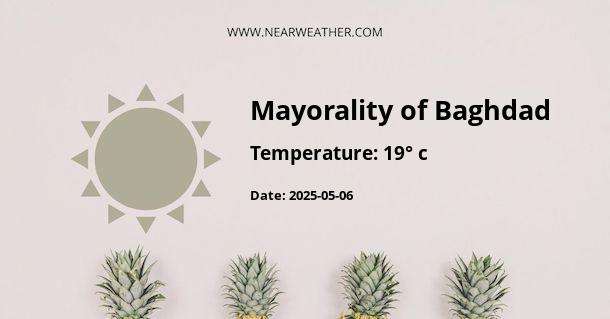Overview of Muḩāfaz̧at Baghdād, IQ
Located in the heart of Iraq, Muḩāfaz̧at Baghdād, also known as Baghdad Province, is the country's largest city and serves as its capital. The region basks in the rich cultural history of Iraq and the Middle East, complemented by a unique climate that shapes its lifestyle, architecture, and agriculture.
Climate and Weather of Muḩāfaz̧at Baghdād: An Overview
The climate in Baghdad Province is characterized as a hot desert climate (Köppen climate classification BWh), which indicates scorching, dry summers and mild to cool winters. The region experiences very little rainfall, with the majority occurring from December to March.
Monthly Average Temperature and Rainfall
The following table outlines the average monthly temperature and rainfall in Baghdad Province:
| Month | Average Temperature (°C) | Average Rainfall (mm) |
|---|---|---|
| January | 12 | 28 |
| February | 15 | 22 |
| March | 20 | 22 |
| April | 26 | 15 |
| May | 33 | 3 |
| June | 38 | 0 |
| July | 42 | 0 |
| August | 42 | 0 |
| September | 37 | 0 |
| October | 29 | 3 |
| November | 20 | 14 |
| December | 14 | 26 |
On average, the temperatures are quite high in Muḩāfaz̧at Baghdād throughout the year, with an average annual temperature of about 26°C. The region experiences its highest temperature in July and August, where it can reach up to 42°C, while the coldest months are January and December, with an average temperature of 12-14°C.
Seasonal Weather in Muḩāfaz̧at Baghdād
The weather in Muḩāfaz̧at Baghdād can be broadly classified into two main seasons: the hot season and the cool season.
The Hot Season
The hot season spans from May to September, with temperatures often exceeding 37°C. The heat peaks in July and August, with an extreme daytime high of around 42°C. The hot season is characterized by clear, cloudless skies, and virtually no rainfall.
The Cool Season
The cool season runs from November to March, with the average daily high temperature below 23°C. This period sees most of the region's rainfall, with January being the wettest month. Nights can be chilly, with temperatures often dropping to single digits.
Impact of Climate on Lifestyle and Agriculture
The desert climate of Muḩāfaz̧at Baghdād has a significant impact on the region's lifestyle and agricultural practices. The high temperatures and lack of rainfall during the hot season necessitate adaptations in various aspects of daily life and farming.
In terms of lifestyle, residents of Muḩāfaz̧at Baghdād have adapted to midday breaks or siestas during the hottest part of the day. Traditional architecture in the region also reflects the climate, with features designed to keep houses cool in the summer and warm in the winter.
As for agriculture, the region mainly relies on irrigation systems to cultivate crops. Dates, wheat, barley, and vegetables are among the primary crops grown in the province.
Final Thoughts
Understanding the climate and weather of Muḩāfaz̧at Baghdād is crucial for anyone planning to visit or live in the region. The hot desert climate necessitates appropriate preparations to ensure comfort and safety, especially during the scorching summer months. Despite the harsh climatic conditions, the region's rich cultural history and resilience of its people make it a fascinating place to explore.
A - Mayorality of Baghdad's Latitude is 33.133331 & Longitude is 44.250000.
A - Weather in Mayorality of Baghdad is 21° today.
A - Climate Conditions in Mayorality of Baghdad shows few clouds today.
A - Humidity in Mayorality of Baghdad is 43% today.
A - Wind speed in Mayorality of Baghdad is 3.71 km/h, flowing at 350° wind direction. today.
